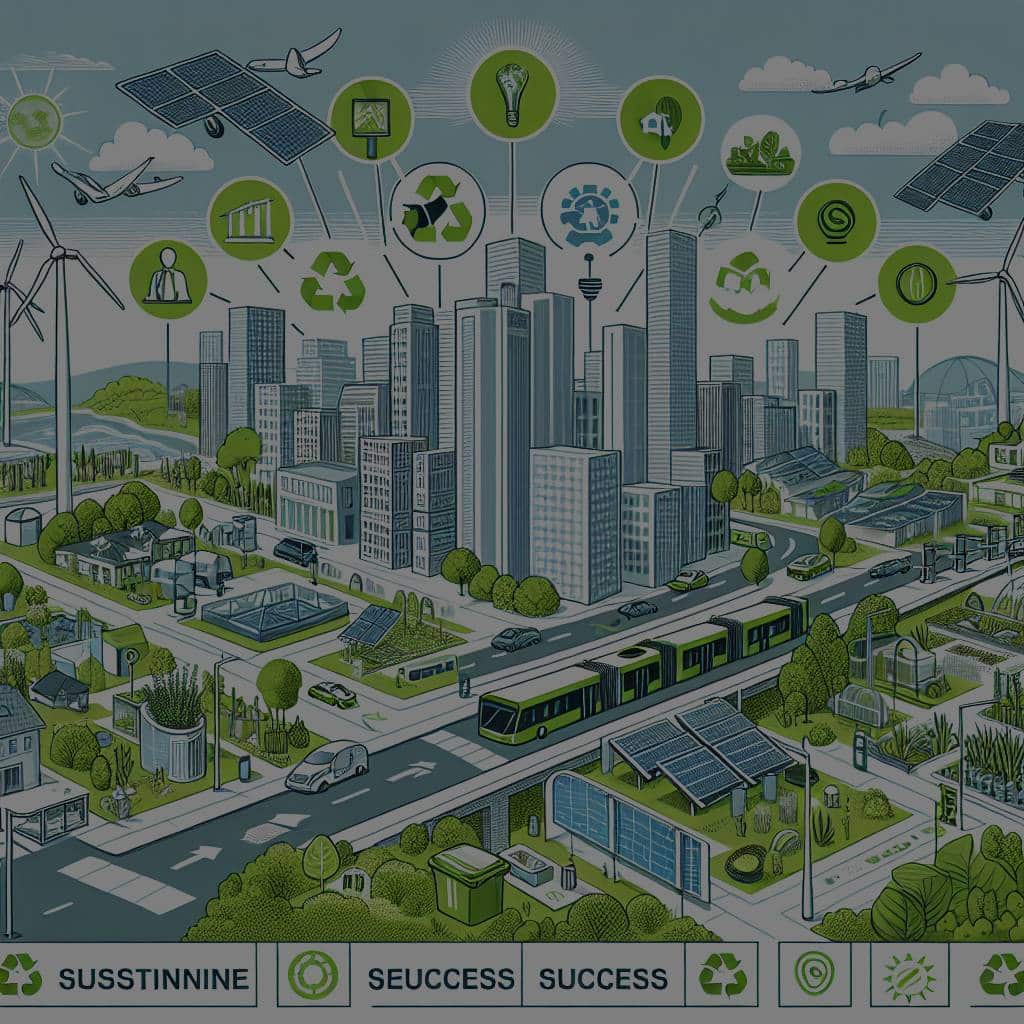What Are the Key Success Factors for Sustainable Urban Development Projects?

When you think of the cities of the future, you probably imagine towering skyscrapers, flying cars, and advanced technology. However, the cities of tomorrow are not just about technological innovation but also about sustainable urban development. The shift towards sustainability is becoming increasingly evident in urban development projects worldwide. But what does it take to successfully implement these projects? What are the key factors that contribute to their success? In this article, we delve deep into these questions, drawing insights from literature and case studies to provide you with a comprehensive understanding of the topic.
Understanding the Concept of Sustainable Urban Development
Before we delve into the success factors, let’s first understand the concept of sustainable urban development. It’s a multidimensional term that encompasses various aspects — from green building and energy-efficient construction to sustainable infrastructure and housing.
Also to read : How to Create a Cost-Effective Digital Marketing Strategy for UK Startups?
Sustainable urban development refers to the process of designing and managing cities in a way that promotes economic growth, social equality, and environmental protection. It’s about making cities livable, resilient, inclusive, and green. It involves the integration of sustainable practices in various facets of urban development, such as housing, infrastructure, energy management, and construction.
Sustainable Urban Development: A Study of Green Cities
The concept of green cities offers an excellent illustration of the implementation of sustainable practices in urban development. Green cities, or eco-cities, aim to reduce environmental impacts through sustainable urban planning and management. They focus on improving the quality of life for their residents while minimizing waste, reducing emissions, and promoting green practices.
In parallel : How to Optimize Telehealth Services for UK Health Care Providers?
Amsterdam, Copenhagen, and Vancouver are notable examples of green cities. These cities have successfully incorporated the principles of sustainable urban development in their city planning and management. They have implemented numerous green initiatives, such as energy-efficient buildings, renewable energy projects, sustainable transportation systems, and comprehensive waste management systems.
By studying these cities, we can identify several factors that have contributed to their success. These include strong political will, comprehensive planning, community involvement, use of innovative technologies, and effective collaboration between various stakeholders.
Key Factors for Successful Sustainable Urban Development
Successful sustainable urban development projects are not a result of a single factor but a combination of several. The literature on the topic suggests that certain factors are more crucial than others.
Strong Political Will
Political will is a critical factor in the success of sustainable urban development projects. Without the commitment and support from the city authorities, it’s challenging to implement and achieve the goals of these projects. The city authorities play a pivotal role in creating the necessary policies, allocating resources, and facilitating collaboration among different stakeholders.
Public Participation
Public participation is another crucial factor. Sustainable urban development is not about imposing changes but about engaging the public in the planning and decision-making process. By involving the public, cities can ensure that the projects meet the needs and expectations of the community, gain public support, and increase the chances of success.
Comprehensive Planning
Comprehensive and strategic planning is essential for the success of sustainable urban development projects. This involves defining clear objectives, developing effective strategies, and establishing performance indicators to measure progress. Comprehensive planning also requires considering the social, economic, and environmental impacts of the projects.
Use of Innovative Technologies
The use of innovative technologies can significantly enhance the efficiency and effectiveness of sustainable urban development projects. This includes technologies for energy-efficient construction, renewable energy generation, waste management, and transportation.
Collaboration Among Stakeholders
Lastly, effective collaboration among various stakeholders — including city authorities, the private sector, non-governmental organizations, and the public — is vital for the success of sustainable urban development projects. Collaboration can facilitate sharing of resources, knowledge, and expertise, and ensure coordination and alignment of efforts.
Practical Implications for Urban Development Projects
The key success factors identified above have practical implications for urban development projects. By understanding and considering these factors, city authorities and project managers can increase the likelihood of successful implementation of sustainable urban development projects.
For instance, political leaders can ensure that sustainability is a key priority in their policies and agendas. They can allocate adequate resources for sustainable projects and create a conducive environment for collaboration and innovation.
Project managers, on the other hand, can incorporate comprehensive planning in their project management practices. They can engage the public and other stakeholders in the planning and decision-making process, use innovative technologies to enhance project execution, and establish performance indicators to monitor progress and make necessary adjustments.
Overall, successful sustainable urban development is about creating a balance between economic growth, social equality, and environmental protection. It’s about building cities that are not just economically prosperous and socially inclusive, but also environmentally responsible.
Case Studies: Sustainable Urban Development
To better grasp the importance of these success factors, let’s examine two case studies that highlight the implementation of sustainable urban development projects. These case studies — one from a developed country and one from a developing country — provide valuable insights into the practicality and challenges of these projects.
Case Study 1: San Francisco, USA
San Francisco, the cultural, commercial, and financial center of Northern California, has been at the forefront of sustainable urban development in the United States. The city’s sustainability efforts are characterized by robust political will, public participation, comprehensive planning, innovative use of technology, and effective collaboration among stakeholders.
The city has implemented several sustainability initiatives, ranging from renewable energy projects and energy-efficient buildings to sustainable transportation systems and affordable housing. For example, the Bayview Hunters Point (BVHP) project, a major redevelopment project, aims to transform an underutilized industrial area into a vibrant, mixed-use, and sustainable community. This project reflects the city’s commitment to creating affordable housing, reducing greenhouse gas emissions, and promoting economic development.
One of the key success factors in San Francisco’s sustainable urban development projects is its effective project management. The city authorities have not only made sustainability a key priority in their policies, but they also ensure that there’s adequate resource allocation, comprehensive planning, and public engagement in these projects.
Case Study 2: Nairobi, Kenya
Nairobi, the capital city of Kenya, provides an interesting example of sustainable urban development in a developing country context. Despite challenges such as inadequate resources and institutional capacity, the city has made significant strides towards sustainability.
For instance, the Kibera Slum Upgrading Project aims to improve living conditions in Kibera, one of Africa’s largest slums. The project involves the provision of affordable housing, improved sanitation, and livelihood opportunities for residents. This initiative underscores the importance of political will, public participation, and collaboration in sustainable urban development.
In both cases, the success of these sustainable urban development projects can be attributed to the aforementioned key factors. They offer valuable lessons and insights into the practical aspects of implementing such projects, providing a blueprint for other cities worldwide.
Conclusion: The Future of Sustainable Urban Development
Sustainable urban development is not just a trend, but a necessity. As we grapple with the challenges of rapid urbanization and climate change, the importance of building sustainable, resilient, and inclusive cities cannot be overstated.
There is no one-size-fits-all approach to sustainable urban development. The success of such projects relies on a combination of factors, ranging from strong political will and public participation to comprehensive planning, use of innovative technologies, and effective collaboration among stakeholders. These success factors, as highlighted in the case studies of San Francisco and Nairobi, are crucial in shaping the trajectory of sustainable urban development projects.
As we look to the future, city authorities and project managers need to keep these key success factors in mind. They need to prioritize sustainability in their policies and agendas, engage the public and stakeholders in decision-making processes, utilize innovative technologies, and foster collaboration.
In conclusion, sustainable urban development is a complex, multidimensional process that requires concerted efforts from all stakeholders. It’s about creating cities that are economically prosperous, socially inclusive, and environmentally responsible. By understanding and implementing the key success factors, we can create sustainable cities that are prepared for the future. Our actions today will determine the world we live in tomorrow. Therefore, let’s strive for sustainable urban development — for our sake and for the sake of future generations.
